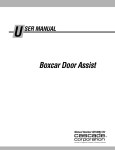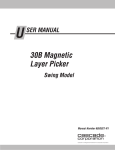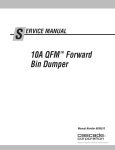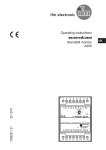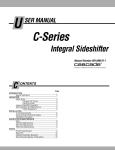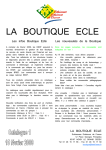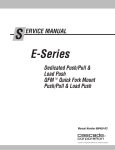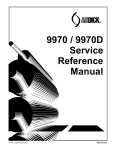Download 6019803R3_Door Assist User Manual
Transcript
U SER MANUAL Boxcar Door Assist Manual Number 6019803 R-3 cascade姞 corporation Cascade is a Registered Trademark of Cascade Corporation C ONTENTS Page INTRODUCTION Special Definitions 1 OPERATOR'S GUIDE Safety Rules 1 Boxcar Door Assist 2 Industrial Lift Trucks 3 General Setup for Opening Doors 4 Picking Up, Securing Unit 4 Opening, Closing Doors 5 Open Docks 5 Close Quarters 6 Disengaging and Stowing 7 Troubleshooting 7 Safe Operation and Maintenance 8 OSHA Regulations 8 INSTALLATION Truck Requirements 9 Electrical Installation 10 INSPECTION & MAINTENANCE Daily 11 100-Hour Maintenance 11 500-Hour Maintenance 11 1000-Hour Maintenance 11 SERVICE Winch Drive Assembly, Cable Replacement 12 Sheaves, Cable Guards, Guide Block 12 Electrical 13 PARTS Product Identification 16 Base Unit 16 Multi-Clamp Tower Assembly 18 Narrow Doorway Boom/Sheave Assembly 19 Recommended Spare Parts back cover Publications back cover Contact Cascade back cover i 6019803 Rev. 3 I NTRODUCTION This User Manual is for the Cascade Boxcar Door Assist and contains an Operator's Guide, Installation Instructions, Inspection & Maintenance, Service and Parts. All specifications are shown in U.S. and (Metric) units where applicable. Special Definitions The statements shown appear throughout this Manual where special emphasis is required. Read all WARNINGS and CAUTIONS before proceeding with any work. Statements labeled IMPORTANT and NOTE are provided as additional information of special significance or to make the job easier. WARNING: Do not operate this unit with an attachment unless you are a trained and authorized lift truck driver. WARNING – A statement preceded by WARNING is information that should be acted upon to prevent bodily injury. A WARNING is always inside a ruled box. CAUTION – A statement preceded by CAUTION is information that should be acted upon to prevent machine damage. IMPORTANT – A statement preceded by IMPORTANT is information that possesses special significance. NOTE – A statement preceded by NOTE is information that is handy to know and may make the job easier. O PERATOR'S GUIDE This Section contains operating instructions for the Cascade Boxcar Door Assist. It will help you avoid common errors which can often cause damage to the equipment or personnel injury. This information is intended to simplify operator understanding about effective and safe Boxcar Door Assist use and operation. Read this information thoroughly before operating the unit. Be sure you know and understand all operating procedures and safety precautions. If you have any questions, or don’t understand a procedure, ask your supervisor. Wireless Remote Control Pickup Guides Sliding Boom, Sheaves, Winch Cable Guards Emphasize Safety! Most accidents are caused by operator carelessness or misjudgement. You must watch for poorly maintained equipment and hazardous situations and correct them. Roll or Bale Clamp Pad Grips Power Harness Cable Release Internal Battery (if equipped) Bumper DA0013.ill Cable & Hook Frame with Fork Slots Front View - Fully Optioned Base Unit 6019803 Rev. 3 1 O PERATOR'S GUIDE Safety Rules – Boxcar Door Assist Assure Door Assist is centered and secure prior to lifting and traveling. Assure fork safety locks are engaged. Assure carriage is equipped with fork stops. DA0053.ill DA0049.ill Safety Chains, Hooks Use gloves when handling and rigging cable. Assure five (5) wraps of cable minimum on drum at all times. Assure cable guards are in place and cable is covered. DA0 Do not operate winch with cover removed. Do not operate Door Assist more than 2 ft. (60 cm) above floor. DA0055.ill DA0050.ill 2 ft. (60 cm) Max. Do not operate Door Assist when tilted. CAUTION: Electrical interlocks prevent unsafe operation with unit tilted, raised too high, or overloaded. (Faults reset automatically in 2-10 sec.) DA0057.ill 2 6019803 Rev. 3 O PERATOR'S GUIDE Safety Rules – Industrial Lift Trucks No riders No reaching through mast No standing under load GA0172.ill Tilt With Load Raise 3 in. (8 cm) No Load P P Traveling empty Motor off, park, lower load RAMPS P Watch clearances No turning on ramp No parking on ramp GA0173.ill TRAFFIC STOP Wet floors 6019803 Rev. 3 Bumps Dips Slow for two-way traffic Sound horn, slow at intersection Sound horn, slow at corner 3 O PERATOR'S GUIDE General setup for opening boxcar doors WARNING – Remain in truck or stay clear of No Stand Zone when opening or closing boxcar door. Assure cable is rigged parallel to door and floor – do not pull with cable at an angle. Cable under tension is hazardous and may result in equipment damage or bodily injury. ON/OFF IN OUT Boxcar Door Assist Unit Hook, Cable Wireless Remote Control NO STAND ZONE defined by door size, movement range Picking up, securing unit 1 Adjust forks to slot width OR Position roll clamp pads on towers ABOVE fork slots DA0042.ill RC1217.ill 2 DA0002.ill OR Short Arm on RH side Position bale clamp pads on towers, pads EVEN with bottom of unit CL1958.ill 3 Pick up or clamp unit and attach safety chains Connect power cable to truck or Internal Battery DA0023.ill DA0018.ill 4 DA0019.ill 6019803 Rev. 3 O PERATOR'S GUIDE Opening, closing doors on open docks 1 A) Tilt mast vertical C) Position unit as low as possible 2 A) Drive forward, touch bumper just beyond door open or close point. 2 ft. (60 cm) Max. DA0065.ill B) Bale Clamp: Pads aligned with bottom of unit B) Set parking brake, truck in neutral. C) Connect hook to lowest anchor point on door 3 A) Release winch B) Manually pull cable from winch. 4 DA0021.ill A) Engage winch, use IN buttons on remote to pull door partially open. B) Assure no loose or falling loads, open door fully. DA0022.ill USING WIRELESS REMOTE Winch Operating LED OUT • Operate winch by pressing both IN buttons simultaneously. • Use OUT button only to release cable tension. Wait for motor to stop before reversing direction. • LED will blink when winch operates. Replace Remote's batteries if LED does not light. Programming receiver for new Remote: Assure Door Assist Unit is level. Press and hold right-side IN button until winch 'pulses' or 'jumps'. Test by pressing OUT. IN OUT Press END BUTTON IN Press BOTH BUTTONS DA0031.ill 6019803 Rev. 3 C) Press OUT button to release tension, use IN buttons to rewind cable. DA0026.ill WARNING: Do not continue pulling if overload sensor deactivates winch. Check for damaged door or load fouling door. Reposition unit or cable connection point on door before trying again. 5 O PERATOR'S GUIDE Opening, closing doors in close quarters using narrow doorway boom 1 A) Tilt mast vertical 2 C) Position unit as low as possible A) Drive forward, allow clearance for door to open. 2 ft. (60 cm) Max. DA0044.ill B) Roll Clamp: Pads positioned above fork pockets B) Set parking brake, truck in neutral. DA0059.ill 3 A) Release winch D) Manually pull cable from winch, connect hook to lowest anchor point on door. 4 A) Engage winch, use IN buttons on remote to pull door partially open. B) Assure no loose or falling loads, open door fully. C) Insert locking pin, thread cable on unit. B) Slide boom for increased pull range. DA0040.ill THREADING CABLE C) Press OUT button to release tension, use IN buttons to rewind cable. Loop around sheave, under cable guard. Pull cable through guide, except when boom is extended 6 DA0054.ill DA0061.ill WARNING: Do not continue pulling If overload sensor deactivates winch. Check for damaged door or load fouling door. Reposition unit or cable connection point on door before trying again. 6019803 Rev. 3 O PERATOR'S GUIDE Disengaging and Stowing CAUTION – All cables and chains must be disconnected and properly stowed before disengaging unit from truck. Follow the procedure shown: 2 1 3 Lower unit to floor. 5 Disconnect and stow power cable. Disengage unit. DA0025.ill 4 Assure cable is rewound with hook stowed. Disconnect and stow safety chains or hooks. DA0041.ill T ROUBLESHOOTING 5 Check fuse, replace if required Check wireless remote for damage, battery condition, replace if required 2 NOTE: If cable runs in wrong direction assure that cable is spooling from underside of drum. + Reprogram code from remote (see page 5) 4 Check power cable, connectors, replace worn or damaged parts 3 Check Receiver LEDs: NOTE: Fault conditions reset automatically in 2-10 sec. 6019803 Rev. 3 1 Green: Red: Yellow: Orange: (all on): Signal OK Overload Fault Tilt Fault Height Fault Overload sensor installed backwards DA0027.ill 7 S AFE OPERATION AND MAINTENANCE OSHA Regulations – Industrial Trucks and Attachments (Specific Regulations from OSHA 1910.178 and 1917.17) WARNING: The safe operation and maintenance of industrial trucks is regulated by Occupational Safety and Health (OSHA) regulations 1910.178 and American National Standards Institute (ANSI) Safety Standard for Powered Industrial Trucks, ANSI B56.1. When operating and maintaining industrial trucks equipped with attachments you should pay particular attention to the following sections of these regulations. You should be familiar with all sections of these regulations. Ask your employer for the complete regulations. (a) General Requirement (4) Modifications and additions which affect capacity and safe operation shall not be performed by the customer or user without manufacturers prior written approval. Capacity, operation and maintenance instruction plates, tags or decals shall be changed accordingly. (5) If the truck is equipped with front-end attachments other than factory installed attachments, the user shall request that the truck be marked to identify the attachments and show the appropriate weight of the truck and attachment combination at maximum elevation with load laterally centered. (6) The user shall see that all nameplates and markings are in place and maintained in a legible condition. (e) Safety Guards (2) If the type of load presents a hazard, the user shall equip fork trucks with a vertical load backrest extension in accordance with: (a)(2) All new powered industrial trucks acquired and used by an employer after February 15, 1972 shall meet the design and construction requirements for powered industrial trucks established in the “American National Standard for Powered Industrial Trucks, Part II, ANSI B56.1”, except for vehicles intended primarily for earth moving or over-the-road hauling. (l) Operator Training Only trained and authorized operators shall be permitted to operate a powered industrial truck. Methods shall be devised to train operators in the safe operation of powered industrial trucks. (m) Truck Operations (1) Trucks shall not be driven up to anyone standing in front of a bench or other fixed object. (2) No person shall be allowed to stand or pass under the elevated portion of any truck, whether loaded or empty. (3) Unauthorized personnel shall not be permitted to ride on powered industrial trucks. A safe place to ride shall be provided where riding of trucks is authorized. (4) The employer shall prohibit arms or legs from being placed between the uprights of the mast or outside the running lines of the truck. (5i) When a powered industrial truck is left unattended, load engaging means shall be fully lowered, controls shall be neutralized, power shall be shut off and brakes set. Wheels shall be blocked if the truck is parked on an incline. (5ii) A powered industrial truck is unattended when the operator is 25 feet or more away from the vehicle which remains in his view, or whenever the operator leaves the vehicle and it is not in his view. (5iii) When the operator of an industrial truck is dismounted and within 25 feet of the truck still in his view, the load engaging means shall be fully lowered, controls neutralized and the brakes set to prevent movement. (6) A safe distance shall be maintained from the edge of ramps or platforms while on any elevated dock or platform or freight car. Trucks shall not be used for opening or closing freight doors. 8 (10) A load backrest extension shall be used whenever necessary to minimize the possibility of the load or part of it from falling rearward. (n) Traveling (4) The driver shall be required to slow down and sound the horn at cross isles and other locations where vision is obstructed. If the load being carried obstructs forward view, the driver shall be required to travel with the load trailing. (7i) When ascending or descending grades in excess of 10 percent, loaded trucks shall be driven with the load upgrade. (7iii) On all grades the load and load engaging means shall be tilted back if applicable, and raised only as far as necessary to clear the road surface. (o) Loading (1) Only stable or safely arranged loads shall be handled. Caution shall be exercised when handling off-center loads which cannot be centered. (2) Only loads within the rated capacity of the truck shall be handled. (3) The long or high (including multiple-tiered) loads which may affect capacity shall be adjusted. (4) Trucks equipped with attachments shall be operated as partially loaded trucks when not handling a load. (5) A load engaging means shall be placed under the load as far as possible; the mast shall be carefully tilted backward to stabilize the load. (6) Extreme care shall be used when tilting the load forward or backward, particularly when high tiering. Tilting forward with load engaging means elevated shall be prohibited except to pick up a load. An elevated load shall not be tilted forward except when the load is in a deposit position over a rack or stack. When stacking or tiering, only enough backward tilt to stabilize the load shall be used. (p) Operation of the Truck (1) If at any time a powered industrial truck is found to be in need of repair, defective, or in any way unsafe, the truck shall be taken out of service until it has been restored to safe operating condition. (q) Maintenance of Industrial Trucks (1) Any power-operated industrial truck not in safe operating condition shall be removed from service. All repairs shall be made by authorized personnel. (5) All parts of any such industrial truck requiring replacement shall be replaced only by parts equivalent as to safety with those used in the original design. (6) Industrial trucks shall not be altered so that the relative positions of the various parts are different from what they were when originally received from the manufacturer, nor shall they be altered either by the addition of extra parts not provided by the manufacturer or by the elimination of any parts. Additional counter-weighting of fork trucks shall not be done unless approved by the truck manufacturer. (7) Industrial trucks shall be examined before being placed in service and shall not be placed in service if the examination shows any condition adversely affecting the safety of the vehicle. Such examinations shall be made at least daily. When industrial trucks are used on a round-the-clock basis, they shall be examined after each shift. Defects when found shall be immediately reported and corrected. Railroad Facilities (Ref. 1917.17) (h) Before being opened fully, doors shall be opened slightly to ensure that the load has not shifted during transit. Special precautions shall be taken if the doors being opened are visibly damaged. (i) If powered industrial trucks are used to open railcar doors, the trucks or the railcar doors shall be equipped with door opening attachments. Employees shall stand clear of the railcar doors while they are being opened and closed. (j) Only railcar door openers or powered industrial trucks equipped with door opening attachments shall be used to open jammed doors. 6019803 Rev. 3 I NSTALLATION Truck Requirements An IC lift truck with forks or clamp attachment is required to pick up the electrically powered Boxcar Door Assist Unit. WARNING – Lift truck must weigh 8000 lbs. (3630 Kg) minimum when using Boxcar Door Assist. Use of lighter truck not recommended. Forks or Clamp Attachment • Forks (2 x 5 x 48 in. L maximum) • Paper Roll Clamp • Bale Clamp Forks Bale Clamp Paper Roll Clamp DA0008.ill Electrical Power Truck-Powered Unit – Requires 12V @ 200A or 24V @ 100A DC power from the truck battery or electrical system. Use the No. 2-gauge twin cable and connectors supplied with the unit (see Page 10 for electrical cable installation). Self-Powered Unit – Contains an internal 12V battery and charger to supply all required power. No truck power connection is required. 6019803 Rev. 3 9 I NSTALLATION Truck-Powered Unit (Steps 1, 2, 4, 5) – Use the No. 2-gauge twin cable, fusebox and connectors supplied with the unit and install as shown. Connect winch power cable to truck and test unit. Self-Powered Unit (Steps 3, 4, 5) – Charge battery using 12V charger supplied. Connect winch power cable to internal battery as shown and test unit. Inline Fusebox (NOTE: located on battery hold-down in self-powered unit) 1 Determine location on truck cowl for power connector • Position connector for easy accessibility and to avoid interference with truck or mast components. • Orient connector to avoid water and dirt buildup if possible. • Mount connector securely using hex capscrews and nuts provided. Fuse: 12V–200A Hex Head Mounting Capscrews + 2 Install power cables, fuseblock to truck battery • Route power cable directly to truck battery terminals. • Assure cables are connected correctly with positive-to-positive and negative-tonegative. Use cable ties as necessary to secure cable. • Mount fuesbox solidly to truck if possible, or secure with cable ties to prevent movement. WARNING – Power cable on truck is always 'hot' and will carry very high current. Assure cable is connected correctly and protected against pinch points or chafing that could cause accidental grounding. 4 Connect power cable to truck, or to unit internal battery Self-powered unit with internal battery, charger DA0076.ill 10 6019803 Rev. 3 I NSTALLATION (Continued) Deep Cycle Battery 5 ENGAGED FREE SPOOL • Move winch lever to Free Spool and pull cable out manually about 3 ft. (1 m). Move lever to Engaged. • Press both 'IN' buttons on remote to pull cable in. Red LED on remote should be flashing and Green LED in controller window should be illuminated. DA0077.eps Battery-to-Winch Power Cable 3 Test unit operation with wireless remote • If required, reprogram receiver (see Operator Guide, Page 5). 12V Battery Charger Charge internal battery (if equipped) • If other LEDs in controller window are illuminated, see Troubleshooting Section, Page 7. 110 VAC • Connect battery charger to power cable and charge battery for 8 hours. I NSPECTION & MAINTENANCE WARNING: After completing any service procedure, always test the Boxcar Door Assist Unit through a complete cycle. First test with no load, then test with a load to make sure the unit operates correctly before returning it to the job. Daily Check items shown each day. Report problems to your supervisor. Pickup Guides Remote Control Operation 100-Hour Complete the following inspection and maintenance on the Boxcar Door Assist Unit: • Check safety chains, hooks and chain anchors for damage. Replace damaged or missing parts. • Check for loose or missing fasteners. Tighten or replace if necessary. Fasteners Power Harness Cable Sheaves, Guards • Check cable sheaves and cable guards for freedom and proper operation. Replace damaged or worn parts. • Check electrical power cable, battery (if equipped) and connectors for damage. Replace damaged or worn parts • Check winch cable/hook by pulling out to full length and assuring there are no frayed or broken strands or kinks in the cable. Replace cable if it does not meet the above inspection criteria. DA0016.eps Cable & Hook 500-Hour 1000-Hour • Replace winch cable. • Replace cable sheeves 6019803 Rev. 3 Internal Battery (if equipped) Safety Chains 11 S 1.0 ERVICE Winch Drive Assembly WARNING: Cable must be spooled onto winch drum from underside. Winch will not operate correctly if cable is spooled from top. See safety decal on brake. There are no field-servicable items on the winch drive assembly except for the cable/wire rope. 1.1 Winch Cable Replacement Retaining Wedge 4 Reinstall leaf-spring brake and use IN buttons on remote to wind the cable, under tension, onto the drum. IMPORTANT: Assure cable is under tension and spools onto drum from underside (see illustration). L L TA E S BL IN A C Insert the retaining wedge alongside the cable and tap into the slot. IMPORTANT: Assure wedge and cable are flush with drum surface when fully seated. M 3 U R Route the free end of a new cable through the center sheaves to the underside of the drum. Insert the cable through the slot in the drum so the free end extends slightly above the drum surface. IMPORTANT: Assure cable is against drum flange. D 2 DA0074.ill Sheave Capscrew 2 Remove damaged cable guard, spring, or complete sheave assembly. Replace with new parts as shown. 3 To obtain proper rotational force on the cable guard, loosen the sheave capscrew and turn the knurled spring cover until the spring tab contacts the roll pin. Rotate the spring cover 1/2-turn more and tighten the sheave capscrew. Cable guard handle should rotate freely 180 degrees (handle outward) and snap back into the safety position against the stop pin (handle inward). Tighten the capscrews as follows: Sheave Capscrew – 175 ft.-lbs. (240 Nm). Base Capscrews – 50 ft.-lbs. (66 Nm) Fairlead Eyepin Capscrews – 5 ft. lbs. (8 Nm) 4 12 Remove and replace worn or damaged guide block. Install the metal cap and tighten the capscrews to 30 ft.-lbs. (40 Nm). Eyepin, Capscrew Spring Cover Sheave bearings are permanently sealed and require no periodic lubrication. Replace worn or damaged parts as described below: Remove the capscrews and eyepins and remove the center sheeves. Note location of shims. Replace with new parts as shown. Cable between center sheaves CAUTION: Use gloves when handling and rigging cable. Serious injuries may result from frayed ends or broken strands. Sheaves, Cable Guards, Guide Block 1 2 E Remove the large safety cover and the leaf-spring brake on the rear of the cable drum. Free-spool the cable out fully and remove cable. NOTE: To disengage cable, loosen retaining wedge by tapping from side-to-side. T TA O R 2.0 1 Cable against drum flange 3 The winch cable must be replaced properly to prevent damage. Follow the procedure below: Pin 3 1 Return Spring Cable Guard 2 Fairlead Shims (2) Sheave Roll Pin Sheave Cap Stop Pin 4 Base (LH, RH) Boom Capscrews (2) Cable Guide Block DA0066.ill 6019803 Rev. 3 S ERVICE 3.0 Electrical 3.1 Main Power Fuse 1 Locate Boxcar Door Assist fusebox, which is near truck battery on truck-powered unit or near battery hold-down on self-powered unit. 2 Remove the cover and replace the fuse as shown. Assure that the stud terminals are reassembled as shown. Cover Positive (+) Battery Cables Fuse: 12V, 200A CAUTION: Assure that the replacement fuse is the correct ampere rating for the winch: 12V system – 200 Amp (Part No. 6017353) Fusebox Base DA0020.ill 3.2 2 Power Cable Harnesses CAUTION: Before working on the contactor and cabling, disconnect the positive battery cable at the truck battery. Power Cable Capscrews, Washers Boxcar Door Assist Unit 1 2 3 Remove the cover from the back of the winch contactor. CAUTION: Cover contains electrical components and wiring - handle carefully to avoid damage. Disconnect the power cable harness from the + and – terminals on the winch contactor by removing the capscrews. Winch Contactor – 2 F F 1 B C Connect the new power cable harness on top of the other cables and wires as shown. CAUTION: Assure correct polarity and that all wires are properly reattached. See illustration and schematics. 3 + D Truck NOTE: Install power cable on top of winch motor cables. A Refer to the ‘Electrical Installation’ Section in this Manual to replace the power cable harness on the truck. Contactor Cover 1 DA0075.ill Power cable to truck (Red stripe = positive lead ) 6019803 Rev. 3 13 S 3.3 ERVICE WINCH POWER CABLE SCHEMATIC Winch Contactor, Motor Power Cables Current Sensor CAUTION: Before working on the contactor and winch cables, disconnect the power cable. 1 2 3 4 Remove the cover from the contactor. CAUTION: Covers contain electrical components and wiring – handle carefully to avoid damage. A F2 Winch Motor – F1 Disconnect the main power cable harness from the + and – terminals on the winch contactor. For reassembly, the main power cable is installed on top of the other cables and exits along the RH side (driver’s view) of the contactor (see illustration below). Winch Contactor – Disconnect the remaining cables and wire harnesses from the contactor. Remove the contactor from the frame. For reassembly, tighten the contactor capscrews to 5 ft.-lbs. (8 Nm). F1 F2 For reassembly, reverse the above procedures with the following exceptions: + IMPORTANT: F1 and F2 cable connections between motor and contactor are swapped: F1 is connected to F2, and F2 is connected to F1. • Install a new winch contactor. CAUTION: Assure all cables and wires are reconnected properly and with correct polarity. Serious damage may result with the cables misconnected. Refer to illustrations and schematics for correct hookup. DA0072.ill A + – Electrical power from truck or internal battery. 3 Winch Motor Power Cables 2 F Current Sensor 4 IMPORTANT: Arrow must point toward negative connection to motor. – 2 F 1 Winch Contactor – Contactor/Circuit Board Cover A F1 F 1 B C + A D Winch Motor Mounting Capscrews DA0071.ill 2 14 Power cable to truck (Red stripe = positive lead) 6019803 Rev. 3 S 3.4 ERVICE CIRCUIT BOARD WIRING HARNESS SCHEMATIC Circuit Board Controller, Wiring Harnesses Current Sensor The Circuit board controller is located inside the small plastic cover on the rear of the Boxcar Door Assist. No field-serviceable components are located on the circuit board. Replace as a complete unit as described below: 1 Remove the circuit board by removing the four (4) screws that fasten it to the inside of the cover. 3 For reassembly, reverse the above procedures with the following exceptions: Black Red Remove the cover from the winch contactor on the backside of the Boxcar Door Assist. Disconnect the two (2) wire harness connectors from the circuit board. 2 Emergency Back-Up Switch White Winch Motor C C – A A Red Black – Contactor F1 Red ow Br + n • Assure both wiring harnesses are properly connected (see schematic and illustration). F2 A B C D • Assure current overload sensor is installed on negative cable between contactor and motor, with arrow pointing toward motor negative connection. Secure sensor to large cable with wire tie . Black Red IMPORTANT: If current sensor is installed backwards, motor will start briefly and stop, and all LEDs will illuminate. To correct, rotate sensor 180 degrees and reinstall. 3-Pin White Circuit Board Controller 4-Pin 1 LED Window Black Black Contactor Cover Red 2 DA0073.ill Red Circuit Board Controller 4-Pin Connector 1 D – C B F 2 3-Pin Connector Controller Wire Harness A F 1 + Height Sensors C A DA0070.ill C Emergency Back-Up Pushbutton Winch Contactor Winch Cover 1 Wire Color: Black Red White 6019803 Rev. 3 Current Sensor Wire Harness Current Sensor IMPORTANT: Arrow must point toward negative connection to motor. 15 P ARTS Base Unit Product Identification – This Section shows replacement parts for the Boxcar Door Assist Unit. Product model number and serial number can be found on the nameplate, or stamped underneath, and must be provided when ordering replacement parts. WARNING: For the safety of yourself and others, DO NOT install the parts shown in this Manual unless you have thoroughly reviewed the appropriate service procedures. Nameplate with model number, serial number, specifications, phone numbers for service. Front View – Fully Optioned Unit @ # $ DA0064.ill 3 2 r 1 e ™ ‡ ¡ 4 5 ⁄ 6 0 w 8 ! £ ) fl (fi ⁄ › 8 ° 9 ¤ ‹ 7 q ¢ ⁄ ‚ Controller Parts ¶ º · B F 2 § + D – C * A F 1 ∞ C C A DA0082.ill • ª 16 ^ & % DA0081.eps 6019803 Rev. 3 P ARTS Base Unit 15A REF QTY ▲ ◆ ■ ● 1 1 2 3 4 5 6 7 8 9 10 11 12 13 14 15 16 17 18 19 20 21 22 23 24 25 26 27 28 29 30 31 32 33 34 35 36 37 38 39 40 41 42 43 44 1 1 4 4 1 1 8 4 4 2 1 6 6 1 6 6 6 1 4 12 2 4 2 2 2 2 1 2 2 1 1 8 1 1 1 1 1 1 1 2 1 1 1 PART NO. DESCRIPTION 6024568 6024569 6015241 6022171 6025812 6020248 6001 629516 6024660 6019902 768538 209043 767614 3550 6020238 206321 202346 6020229 202348 768556 6020689 6020233 787383 787381 6016660 683162 6020106 682999 787398 767961 6021248 6021751 6021355 6019453 6019450 206322 6021112 6021110 6024410 6025862 6024807 6026851 6036925 6389 6021752 6028481 6026661 Base Unit – 12V Base Unit – 24V Winch – 12V Winch – 24V Cable Assembly ▲ Knob ▲ Square Nut, .375 Capscrew, .375 x 1.00 Spring Tensioner Platform Weldment Capscrew, M10 x 30 Washer, M10 Capscrew, M10 x 20 Capscrew, .25 x .375 Winch Cover Capscrew, M6 x 16 Washer, M6 Bumper, Rubber Washer, M12 Capscrew, M12 x 45 Bushing Brake Pad Washer, M10 Nut, M10 Sheave ◆ Shim ◆ Pin ◆ Eye Pin ◆ Washer, M8 ◆ Capscrew, M8 x 16 ◆ Fairlead Weldment ◆ Safety Chain Assembly Safety Chain Assembly Power Wire Assembly, Base Unit Power Wire Assembly/Fuseblock, Truck Washer, M10 Controller Assembly Cover ■ Circuit Board ■ Wire Harness Emergency Release Pushbutton Current Sensor Winch Contactor ▲ Lockwasher, .25 Guard Cable Wedge Anchor ● Remote Transmitter Included with Winch. Included in Center Sheave Assembly 6021908. Included with Controller Assembly 6021112. Included with Cable Assembly 6025812. Reference: SK-7152. 6014809 Rev. 3 17 P ARTS Multi-Clamp Tower Assembly 4 9 0 8 5 8 5 6 7 3 1 2 0 9 DA0036.ill ! Tower REF QTY 1 2 3 4 5 6 7 8 9 10 11 18 1 6 6 2 4 2 2 2 2 24 2 PART NO. 6021945 6020171 215419 679082 6020627 787398 686119 767414 765352 6020249 783608 6020224 DESCRIPTION Tower Assembly Tower Weldment Washer, M20 Capscrew, M20 x 35 Whip Spring Washer, M8 Lockwasher, M8 Nut, M8 Capscrew, M8 x 30 Rubber Pad Capscrew, M10 x 16 Bar 6014809 Rev. 3 P ARTS Narrow Doorway Boom/Sheave Assembly 5 8 0 7 2 3 6 ! 9 @ # 1 7 4 5 DA0037.ill 8 7 4 6 6 2 3 Boom Assembly REF QTY 1 2 3 4 5 6 7 8 9 10 11 12 13 1 2 1 1 1 4 4 4 1 1 1 3 3 PART NO. 6021930 6016659 767614 6020120 6020181 6018002 205205 683822 763025 6021532 6021683 6021668 202251 683821 ◆ See parts breakdown. 6014809 Rev. 3 1 DESCRIPTION Sheave Boom Assembly Tube – Slide Capscrew, M10 x 20 Sheave Assembly – LH ◆ Sheave Assembly – RH ◆ Pin Detent Capscrew, M12 x 90 Lockwasher, M12 Nut, M12 Plate Cap Guide Washer, M12 Capscrew, M12 x 20 LH Shown (Driver's View) DA0038.ill Sheave Assembly REF QTY 1 1 2 3 4 5 6 7 1 1 2 1 1 1 1 1 PART NO. 6020120 6020181 6020116 6020180 683161 6016660 6018808 6018807 6018795 790762 DESCRIPTION Sheave Assembly – LH Sheave Assembly – RH Base – LH Base – RH Shim Sheave Sleeve Torsion Spring Guard Capscrew, M20 x 75 19 P ARTS Recommended Spare Parts Boxcar Door Assist PART NUMBER UNITS SERVICED DESCRIPTION 6016660 6021668 6021811 6028481 6026661 6019450 6017353 ECR2032 Sheave w/Bearing Cable Guide Block Cable/Hook Assembly Cable Wedge Anchor Wireless Remote Truck Power Harness/Fuseblock 200A Fuse (12V) Wireless Remote Battery 1-5 6-19 20-50 2 1 1 1 1 1 1 1 2 2 2 2 1 1 2 2 4 4 4 4 1 1 3 3 Publications Boxcar Door Assist PART NO. 6019803 679929 673964 6024073 䊛 cascade L LS T OO S ICE ERV UA MAN Service Literature Index and Order Form Ordering Information FAX: Mail: !"#"$ #%$&' () "*' + , '! Master Service Manual Phone: !"#"$$#!!%% - *&"%*% . "# + /!,''' U DESCRIPTION User Manual (Operation, Installation, Service, Parts) Tool Catalog Literature Index Order Form Promotional CD SER MANUAL cascade姞 Cascade is a Registered Trademark of Cascade Corporation GA0098.ill Contacting Cascade Users – Cascade product literature, service literature, parts and videos are available through authorized lift truck dealers. To find the dealer nearest you, contact: North America/South America Cascade Corporation U.S. Headquarters 2201 NE 201st Fairview, OR 97024-9718 Tel: 800-CASCADE (227-2233) 503-669-6300 Fax: 888-329-8207 Lift Truck Dealers – To order parts, service literature or videos: c © Cascade Corporation 2005 Europe Cascade N.V. European Headquarters P,O, Box 3009 1300 El Almere Damsluisweg 56 1332 ED Almere The Netherlands Tel: 31-36-5492911 Fax: 31-36-5492964 Cascade Parts Sales 2501 Sheridan Ave. Springfield, OH 45505 Tel: 888-CASCADE (227-2233) FAX: 888-329-0234 11-2005 Part Number 6019803 R-3






















